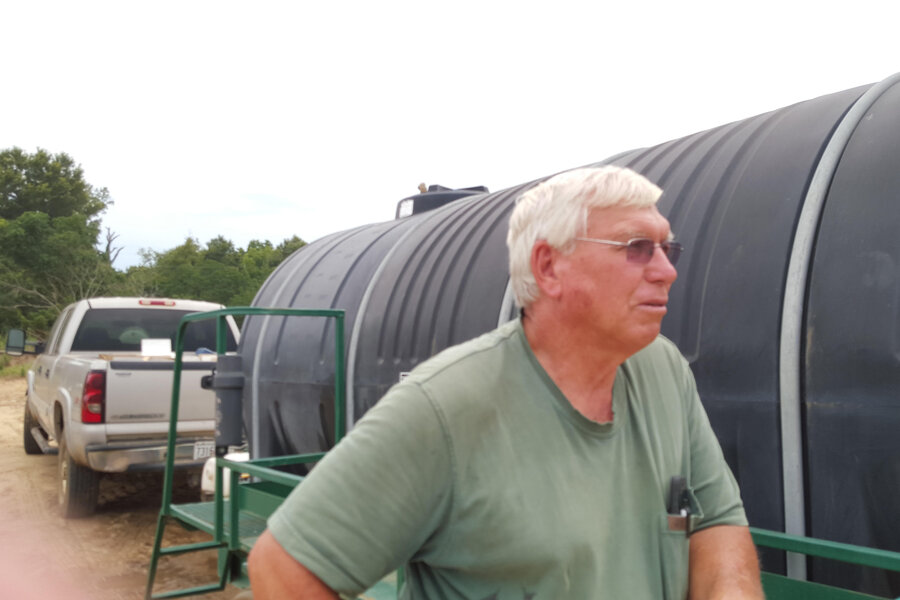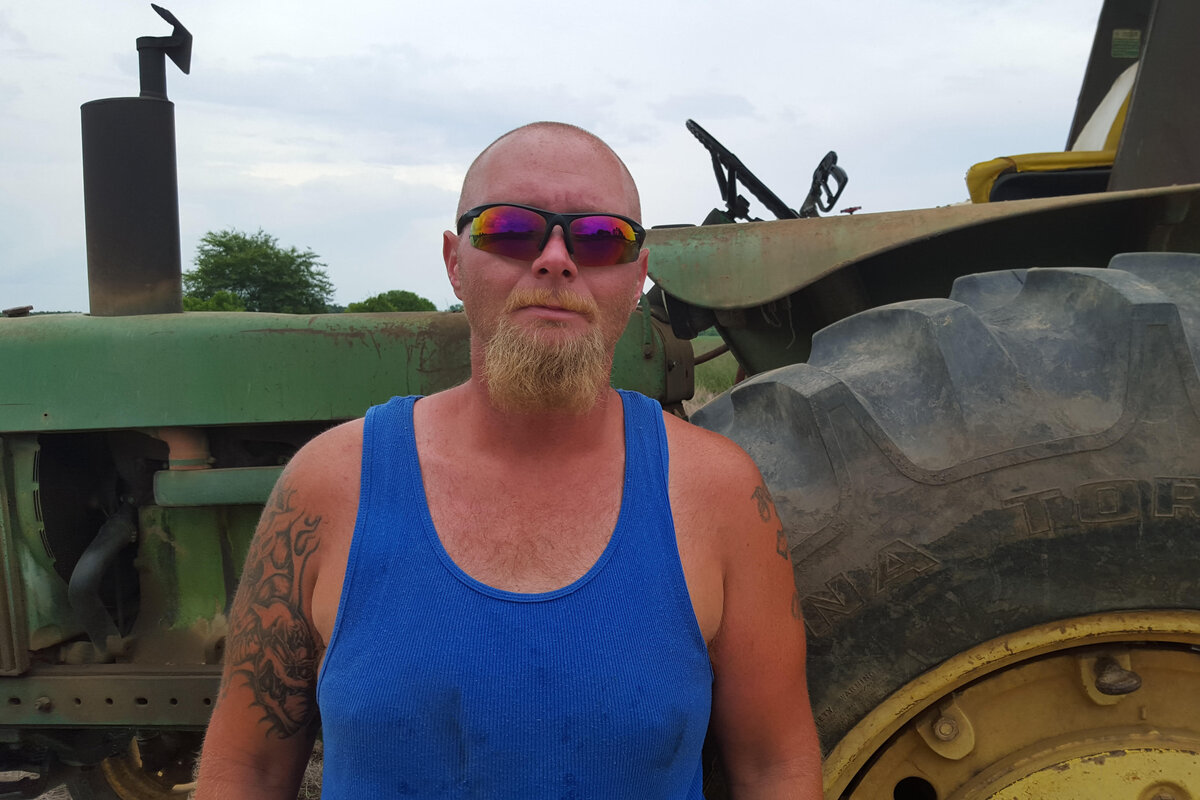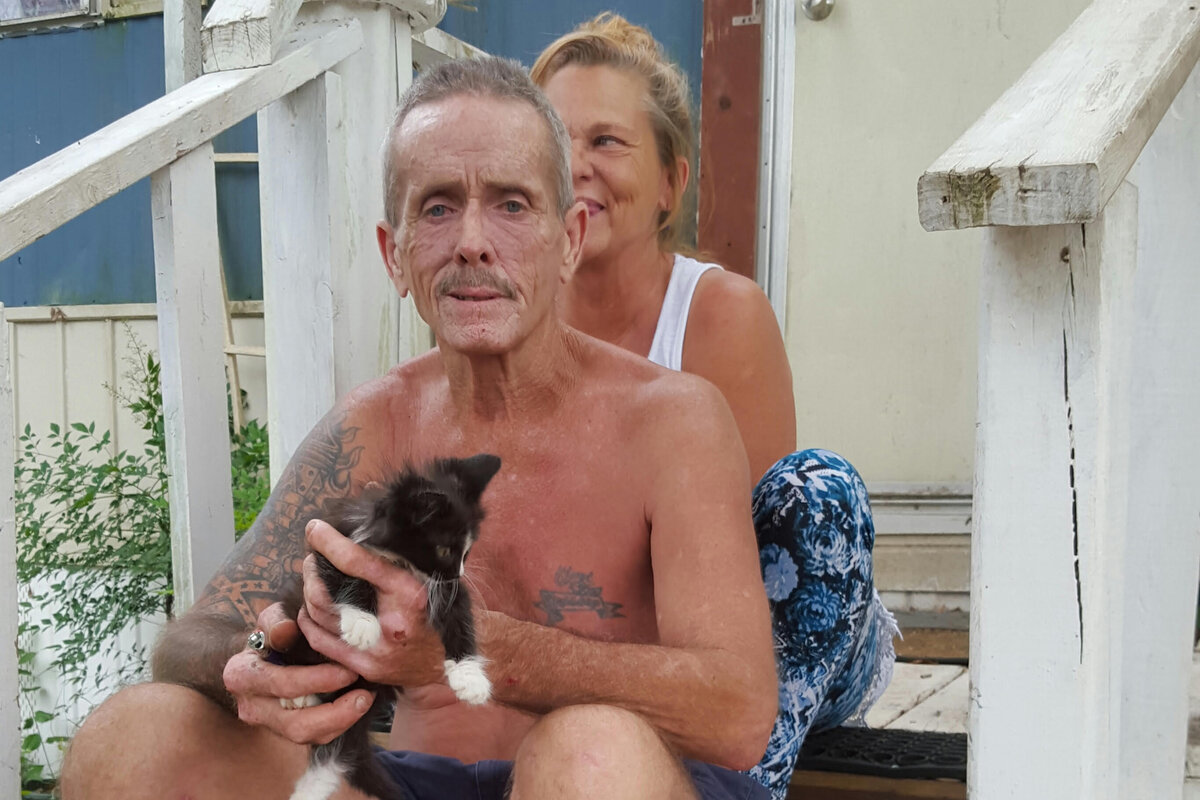Rural America confronts a new class divide
Loading...
| HAWKINSVILLE, Ga.
The rows of low-slung plants under the hot Georgia sun are deceptive: It’s what grows underground that counts.
“I love this dirt more than anything – except my son,” says farmhand Franklin “Spanky” Laidler, jumping off his red tractor onto a field where peanuts burrow in the ground.
For many, that love of this sandy Southern soil is more than just a way of life, it’s a wealth generator. Mr. Laidler says he works so much that if he was paid hourly instead of salaried, “I’d be a millionaire.” Instead, it’s his boss who has grown wealthy on these 9,000 acres. “He could quit farming now and he’d have nothing to worry about.”
A different harvest takes place at the Pulaski County dump, just outside Hawkinsville. At night, men with headlamps, like monster fireflies, pick through the day’s detritus looking for valuable scraps to sell.
These are two pictures of income inequality in rural America.
The widening gulf between the haves and have nots is not limited to the Rust Belt’s cast-off manufacturing workers, working class suburbanites, or inner-city poor working on a stagnant minimum wage. The same trends have taken hold in farm country, though in different forms. The farms that once generated wealth for entire communities are now creating a new class of superfarmers.
The trend is not unprecedented. When the South was more agrarian, the divide was worse – land ownership was the ultimate “unequalizer.”
But after a period of more equal wealth, the trend is clearly back toward greater inequality, with more money in the hands of the few. Automation has made farm jobs disappear, and at the bottom of the income ladder, many rural residents are still struggling to recover from the Great Recession.
For places like Hawkinsville, these trends represent a deepening challenge for how to sow hope. And yet, rural America retains some advantages for addressing those broken hopes. It begins, experts say, with a willingness to reject the tendency toward insularity and open arms and minds to new ideas.
“Communities that are waiting for either [Donald] Trump or [Hillary] Clinton to come into office and solve all their issues are being unrealistic,” says David Peters, a rural sociologist who studies heartland inequality at Iowa State University in Ames. “Residents and community leaders do, however, have this power to build up trust in the community … [in order] to marshal investment and resources. Yes, it’s difficult. But it’s within their power to change.”
Hidden wealth
The most striking thing about rural America's inequality is what you don't see. Wealth is not marked by gated communities or mansions. Fashion plates do not strut along Commerce Street in downtown Hawkinsville. Indeed, there’s a ramshackle air to the place, broken only occasionally by the one sign of ostentation: brand-new Ford F-350s growling down the highways.
Yet wealth has been growing here until recently – in part because of a short-term turn in the farming cycle; in part, because of long-term consolidation.
A run of high prices in the aftermath of the Great Recession meant farmers like Gary Dawson were able to slash their debts and pay cash for tractors and more land. He could expand because bigger machinery and improved soil-conditioning techniques allowed him to farm more land more efficiently.
“We started with a four-row harvester and now we’re running a 12-row one,” he says.
The farming cycle is now turning against farmers. Net cash farm income is expected to fall for the fourth year in a row this year. Midwestern farmland prices have fallen sharply from record highs. Nevertheless, by expanding and becoming more efficient, Mr. Dawson is joining the ranks of superfarmers – a longterm trend that is putting farm production and wealth into fewer and fewer hands.
The level of concentration varies by crop and by region.
A quarter-century ago, the South's big cotton farmers (with at least 1,000 acres planted) were already producing 30 percent of the nation's crop; by 2007, it was half, according to the United States Department of Agriculture. Midwestern corn and soybean farmers – once the backbone of a rural middle class – are moving in the same direction. By 2007, big farmers produced nearly a third of the corn crop (up from 9 percent in 1992).
“What most people think of as family farms don’t exist in large numbers anymore, but what exists are large family businesses … in the $3 to $5 million range,” says Mr. Peters, the Iowa State sociologist.
Big farms get richer
And the bigger the farm, the bigger its average profit margin. By 2011, as crop prices were rising, the average midsize family farm was worth $2.6 million and earned $156,000 a year – two-thirds of that from farming. Large family farms were worth $4.8 million and earning $413,000; very large farms, just under $10 million and earning $1.7 million.
As this wealth accumulates, it is being spread to fewer and fewer people. The midsize to very large operations represent less than 8 percent of the 2.1 million farm households in the United States, most of which rely on income outside agriculture for their livelihood. And as the big operations become more mechanized and efficient, they're not hiring droves of new farmhands. Mr. Dawson has reduced his permanent crew from dozens in the 1970s to about nine today.
“A typical [large] farmer is not going to admit that they’re making hundreds of thousands of dollars a year, in part because nowadays … those who have traditionally performed jobs on the farm are left out of any sort of share in the wealth that’s being produced,” says Jonathan Bryant, a history professor at Georgia Southern University in Statesboro, who studies small-town life in the South. “That’s become a difficult situation for a lot of folks, and many just leave. Those that don’t are the people you see in those clustered groups of rotting trailer houses: They’re stuck as much as some person in a Central American country is stuck.”
In Hawkinsville, over half of its high school graduates leave for college or someplace else every year and don’t come back. Despite his success in farming, Dawson's children have gone on to professional work elsewhere. His daughter is an architect; his son works at Robins Air Force Base, just up the road, as a software technician.
Permanent 'yard sale'
For those who haven’t shared in the farm boom, the disparity looks exactly like despair.
Count Rex Milner and his wife, Leeanne, among them. As a just-weaned kitten attacks a rock in their front yard, they describe what seems a far cry from a rural paradise in middle Georgia. Yes, they can float down the lazy Ocmulgee River in inner tubes – the local go-to entertainment. But as with hundreds here, the Milners rely not on a paycheck but on a federal disability check, which they pad with what amounts to a permanent yard sale. “You’ve got to scrounge for every dollar you get,” says Mr. Milner, a junk dealer who combs the countryside and flea markets for items he can mark up and sell. “It’s never been this bad, the economy.”
They’d love to move to another place and start over. But cash-poor and burdened with high-interest debt, he says, “We’re stuck."
For the most part, locals like the Milners don’t blame big farmers. After all, it’s hard to criticize those whose hard work has been bolstered by good fortune, even though they may have been born into a land-rich family. Instead, it’s Hillary Clinton or President Obama who are the main targets of bitter complaints.
"Inequality works both ways: It’s not just concentration of wealth, but it’s also what happens at the bottom,” says Peters, the rural sociologist. “The upshot is that the trend of the withering middle class has occurred in rural areas much further and quicker than in urban and metro communities in general.”
The current rural inequality is not unheard of, at least in the South.
“We have seen this kind of inequality before, and it’s when we were highly agriculturally dependent in the nation,” says Linda Lobao, a rural sociologist at Ohio State University in Columbus. “It’s always the case with land in rural communities: land makes power. And power often doesn’t want change."
Farmers in the 1970s also saw several good years back-to-back and bid up land prices, only to see the farm economy collapse in the 1980s. When land prices crashed, many indebted operators lost their farms Another price downturn could happen, squeezing farm incomes again. Net cash income is projected to fall by a third this year versus the 2012 peak. And land prices have already begun to ease downward.
Hawkinsville is not thriving: A restaurant featuring “best burgers in town” is not open at the supper hour. Town fathers have been working for 30 years to renovate an old opera house, But it's still not done. An old firehouse shows cracks in its foundation, waiting, year after year, for renovation.
Power of openness
Sociologists say reforms may have to run deeper than opera house grants for many divided farm towns grappling for survival in the new economy.
According to Peters and Professor Lobao, rural communities that have managed to thrive despite the dour employment dynamics exhibit similar values: an openness to change and outsiders. In many parts of the country, rural towns that have welcomed immigrants, especially, have seen their downtowns, if not thrive, at least manage a slower population decline than more insular communities.
Last year, the White House Rural Council launched Rural Impact, which is helping 10 rural and tribal communities fight income inequality primarily by giving children more educational options. Agriculture Secretary Tom Vilsack calls it a “whole-family framework for addressing child poverty.”
More broadly, “the key is to try to organize people in some manner to put more claims on local government, to gain more political power,” says Lobao. In many income-divided towns, she adds, there’s a sense that those who don’t farm are “subject to forces that are beyond their control, which leads to a more fatalistic approach.”
But in a recent survey of 99 struggling farm towns, adds Peters, “we find that communities that have higher levels of social capital – the level to which people trust one another, and whether they’re tolerant of different opinions and allow newcomers to be involved in decisionmaking and power structures – those tend to have better economic and demographic outcomes.”
[Editor's note: The cutline for the photo of Franklin 'Spanky' Laidler has been corrected to correspond with his quote in the story.]








